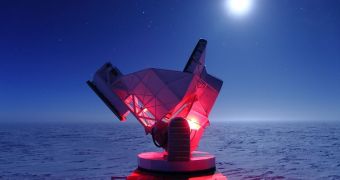New results obtained from observations conducted with the 10-meter South Pole Telescope (SPT) appear to confirm the nature of dark energy, the fact that Albert Einstein's cosmological constant is real, and also get closer to establishing the exact masses of all types of neutrinos.
These data are all the more spectacular when considering that the volume of SPT data use in this study is only a fraction of the entire dataset obtained by the telescope thus far. According to experts, the research took into account information on just 100 of the 500 galaxy clusters the observatory analyzed.
Scientists at the Harvard-Smithsonian Center for Astrophysics (CfA) say that the new results are very important, since they appear to confirm that dark energy is indeed real. Astrophysicists believe that dark energy is the force that is currently driving the ever-accelerating universal expansion.
If it did not exist, then the Universe should have started collapsing back in on itself – under the force of gravity – long ago. Rather than slowing down, it is expanding outwards at an accelerating pace, which is impossible under our current understanding of the laws of physics (unless another force is involved).
“With the full SPT data set we will be able to place extremely tight constraints on dark energy and possibly determine the mass of the neutrinos,” University of Chicago (U-C) Kavli Institute for Cosmological Physics postdoctoral scientist, Bradford Benson, said.
The expert made the statement during a presentation of the SPT results, which he held yesterday, April 1, at the American Physical Society meeting, in Atlanta. He explained that data from the South Pole Telescope were augmented with X-ray readings from satellites in Earth's orbit.
“Right now, the forefront of physics is observational cosmology. We observe signs of dark energy, dark matter, and early inflation, but we don't understand any of them. The South Pole Telescope's mission is to provide some answers,” CfA expert and SPT co-principal investigator, Antony Stark, added.
It could be that dark energy is in fact a manifestation of Einstein's cosmological constant, a factor that Einstein introduced into his theory on general relativity so he could accommodate the stationary Universe idea into it.
Another explanation for the accelerated expansion of the Universe could be that the force of gravity acts oppositely at great distances. That is to say, it leads to repulsion of large-scale cosmical structures, rather than attraction.
“Clusters of galaxies are the most massive, rare objects in the universe, and therefore they can be effective probes to study physics on the largest scales of the universe,” concludes the leader of the SPT Collaboration, U-C expert John Carlstrom.

 14 DAY TRIAL //
14 DAY TRIAL //